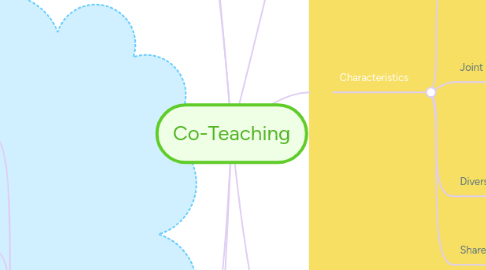
1. Approaches
1.1. One Teaching, One Observing
1.1.1. One teacher teaches while the other collects data
1.1.2. Drawback: one teacher could be seen as the assistant.
1.1.3. Decisions for analysis should be made together.
1.2. Station Teaching
1.2.1. Equal parties-each is responsible for planing and teaching half of content.
1.2.2. noise and movement could be problematic
1.3. Parallel Teaching
1.3.1. Main purpose is to lower student-teacher ratio
1.3.2. Each teacher teaches half the class
1.3.3. Best for drill and practice, review, and projects
1.4. Alternative Teaching
1.4.1. a smaller group of students participate in different activities than the larger group
1.4.2. assessments, enrichments, or intensive instruction
1.4.3. runs the risk of stigma
1.5. Teaming
1.5.1. both teachers are responsible for a lesson
1.5.2. greatest level of trust and commitment
1.6. One Teaching, One Assisting
1.6.1. one teacher is teaching, the other is supporting students
1.6.2. one teacher could be looked at as the assistant
1.6.3. could be distracting
2. Relationships
2.1. Philosophy and Beliefs
2.1.1. understanding and respecting one another's beliefs.
2.2. Parity Signals
2.2.1. finding was to show each other and the students that both teachers are of equal status
2.3. Classroom Routines
2.3.1. Being on the same page for expectations of students
2.4. Discipline
2.4.1. discussed and agreed upon expectations of student behavior and what protocols to implement.
2.5. Feedback
2.5.1. knowing and respecting preferred methods and styles of feedback
2.6. Noise
2.6.1. Knowing and respecting tolerable noise levels
2.7. Pet Peeves
2.7.1. knowing and respecting the things that bother the other teacher a great deal.
3. Planning
3.1. lack of time
3.1.1. creating more time: use substitutes, alternatives for class coverage, instructional strategies that facilitate planning.
3.2. must use available time to fullest extent possible
3.3. being mindful of planing procedures
3.4. as more collaborative relationships form less time is needed for planning
4. Definition
4.1. "Co-teaching is a service delivery model option for providing specialized services to students with disabilities or other special needs while they remain in their general education classes"
5. Friend, M., & Cook, L. (2013). Co-Teaching. In Interactions: Collaboration Skills for School Professionals (7th ed.). Pearson.
6. Characteristics
6.1. Two or more professionals with different Primary areas of Expertise
6.1.1. Co-Teachers are peers, this does not include para-educators.
6.1.1.1. Classrooms with para-educators are supported or assessisted
6.1.2. Powerful and effective because different types of expertise are used conjointly.
6.2. Joint Delivery of Instruction
6.2.1. "Colleges share decision making about instruction and ensure that both have active roles in teaching"
6.2.2. use instructional strategies that engage all students.
6.2.3. Enhanced learning options
6.3. Divers group of students
6.3.1. diverse learners
6.3.2. Must be careful not to socially isolate students with exceptionalities
6.4. Shared classroom Space
6.4.1. Most learning, for all students, takes place in one shared space

